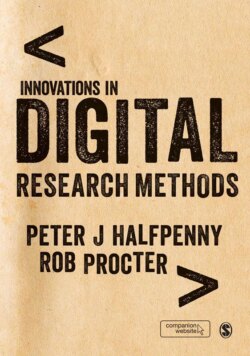Читать книгу Innovations in Digital Research Methods - Группа авторов - Страница 24
На сайте Литреса книга снята с продажи.
Chapter 9: Digital Records and the Digital Replay System
ОглавлениеAs many of the contributors to this book recognize, the capacity to capture behaviour through the ‘digital footprint’ that people generate as a by-product of their everyday activities has the potential to transform the practice of empirical social science. In this chapter, Crabtree, Tennent, Brundell and Knight examine how new tools for data collection and analysis make it possible to exploit this data. Their discussion focuses in particular on the development of ‘digital records’ that enable social science researchers to combine novel and heterogeneous forms of digital data, such as video, text message logs and GPS data, with more traditional and established forms, such as audio recordings and transcriptions of talk.
The authors describe the Digital Replay System (DRS), an open source, extensible suite of interoperable tools for assembling, synchronizing, visualizing, curating and analysing digital records.3 In Chapter 5, Lambert presents solutions to the data management problems attendant in the use of conventional kinds of social data such as surveys. From this perspective, DRS can be viewed as a prototype for meeting the data management and linking challenges presented by novel sources of social data. Crabtree and his co-authors provide a step-by-step exposition of several different examples; these include capturing rich accounts of people’s physiological reactions while on a fairground ride, a corpus linguistics perspective on visitors’ interactions in an art gallery, and disaster mapping and management. Collectively, these examples illustrate how the use of a system like DRS can enable the assembly of digital records capturing a wide range of interactions between people that are a by-product of their use of various digital devices, and make them available for subsequent visualization, curation and analysis. Finally, the authors consider future developments, particularly the prospects for making use of mass participation in social science research through the use of mobile devices for the crowd-sourcing of data.
